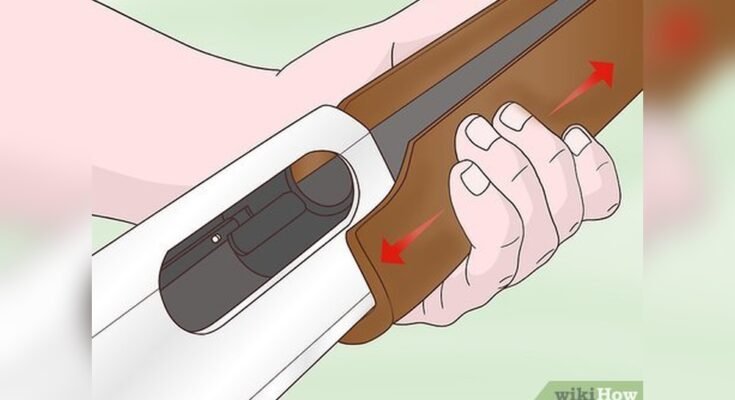If you own a pump-action rifle, keeping it in top shape is key to its performance and your safety. But how do you make sure your rifle stays reliable every time you use it?
Proper maintenance might seem tricky, but with the right steps, you can easily care for your rifle yourself. You’ll discover simple, effective ways to clean and maintain your pump-action rifle. By the end, you’ll feel confident handling your weapon like a pro—and avoid costly repairs down the line.
Ready to get started? Let’s dive in.

Basic Maintenance Tools
Maintaining a pump-action rifle needs the right tools. Basic maintenance tools keep your rifle clean and working well. They help stop rust, jams, and wear. Having these tools ready makes cleaning easier and safer.
Essential Cleaning Kit
A cleaning kit has brushes, rods, and patches. Brushes remove dirt and carbon from the barrel. Rods help push patches through the barrel for cleaning. Patches soak up oil and dirt. Choose kits made for your rifle’s caliber size.
Lubricants And Solvents
Solvents break down gunpowder, carbon, and grime inside the rifle. Lubricants keep moving parts smooth and stop rust. Use oil sparingly on metal parts that move. Too much oil can attract dust and dirt. Pick products made for firearms to avoid damage.
Protective Gear
Wear gloves to protect your skin from chemicals. Eye protection stops dust and solvent splashes from harming your eyes. Use a clean workspace with good light. Protect your clothes with old shirts or aprons. Safety keeps cleaning hassle-free and safe.
Disassembly Steps
Disassembling a pump-action rifle is essential for proper maintenance. It helps clean all parts and keeps the rifle working well. Follow each step carefully to avoid damage.
Safety First
Always check the rifle is unloaded before starting. Remove all ammunition from the area. Point the rifle in a safe direction. Wear safety glasses to protect your eyes. Safety is the top priority during disassembly.
Removing The Barrel
Locate the barrel release or retaining screw. Use the correct tool to loosen it gently. Pull the barrel forward and away from the receiver. Handle the barrel carefully to avoid scratches. Set the barrel aside on a soft surface.
Separating The Pump Mechanism
Slide the fore-end or pump handle forward. This exposes the action bars and internal parts. Press any release buttons or levers to unlock the pump. Remove the pump mechanism slowly and steadily. Keep all small parts in a container to avoid loss.
Cleaning The Barrel
Cleaning the barrel is a key step to keep a pump-action rifle working well. Dirt, powder residue, and metal particles build up inside the barrel. This buildup affects accuracy and can cause damage. Regular cleaning helps the rifle shoot smoothly and last longer.
Removing Residue
Start by removing loose residue from the barrel. Use a cleaning rod with a patch soaked in solvent. Push the patch through the barrel several times. This softens and lifts dirt and powder residue. Repeat with clean patches until they come out almost clean.
Using A Bore Brush
Next, use a bore brush to scrub inside the barrel. Attach the brush to the cleaning rod. Push it through the barrel with firm, even strokes. The brush scrapes off stubborn residue and fouling. Use the brush several times, then run a patch to remove loosened debris.
Drying And Inspecting
After cleaning, dry the barrel with a dry patch. Make sure no solvent or moisture remains. Check the inside with a bore light or look through the barrel. The surface should be clean and shiny without rust or damage. Proper drying prevents corrosion and keeps the rifle safe to use.
Lubricating Moving Parts
Lubricating moving parts is a key step in maintaining a pump-action rifle. It keeps the rifle working smoothly and prevents wear. Proper lubrication helps avoid rust and damage caused by friction. It also ensures reliable performance when you need it most.
Key Areas To Lubricate
Focus on the bolt, slide, and trigger assembly. These parts move often and face the most friction. The pump action mechanism and the rails where the slide moves also need oil. Don’t forget the extractor and ejector. They help remove spent shells and need smooth action.
Choosing The Right Oil
Use a high-quality gun oil made for firearms. It should protect metal parts and resist dirt and dust. Avoid heavy oils that attract grime or light oils that dry too fast. Synthetic oils often work well in different weather conditions. Check labels to ensure suitability for pump-action rifles.
Applying Lubricant Properly
Apply a small amount of oil to each moving part. Use a cloth or a dropper for control. Too much oil can cause buildup and attract dirt. Spread the oil evenly but avoid dripping. Move the action back and forth to distribute the lubricant inside. Wipe off excess oil with a clean cloth.
Inspecting For Wear And Damage
Inspecting a pump-action rifle for wear and damage keeps it safe and reliable. Regular checks help catch small problems early. This stops bigger issues later. Simple inspections reveal if parts need repair or cleaning. Safety depends on knowing your rifle’s condition.
Checking The Pump Action
Slide the pump back and forth smoothly. It should move without sticking or rough spots. Look for cracks or dents on the pump handle. Check the rails for dirt or damage. Clean any debris that blocks the action. A smooth pump ensures quick, safe shooting.
Examining The Firing Mechanism
Open the rifle’s action and inspect the firing pin and trigger. Look for rust, wear, or bent parts. Make sure the firing pin moves freely. The trigger should reset after each shot. Test the safety catch to confirm it works well. These parts control firing and need to be in top shape.
Identifying Common Issues
Watch for loose screws or worn springs. Check the magazine tube for dents or rust. Listen for unusual noises during operation. Signs of wear include metal shavings or powder residue. Early detection avoids jams and misfires. Fix small issues before they grow.
Reassembly Tips
Reassembling a pump-action rifle needs care and focus. Proper reassembly keeps the rifle working well. It also ensures your safety and extends the rifle’s life. Follow these tips to put your rifle back together correctly after cleaning or repairs.
Aligning Components Correctly
Start by placing each part in its right position. Check the manual for exact placement. Parts must fit snugly without forcing. Align the bolt, slide, and trigger assembly carefully. Misaligned parts can cause jams or damage. Take time to ensure everything lines up smoothly.
Testing Functionality
After assembly, test the rifle’s moving parts. Pump the action several times to check smoothness. Dry fire with snap caps for safety. Listen for unusual sounds or resistance. Ensure the trigger resets correctly each time. Confirm the safety switch works as it should.
Final Safety Checks
Double-check the rifle before use. Make sure the chamber is empty. Verify the safety is engaged. Inspect the stock and barrel for damage. Clean any leftover debris from assembly. Keep the rifle pointed in a safe direction throughout. Safety first, always.
Storage Recommendations
Proper storage is key to keeping a pump-action rifle in good shape. It helps avoid damage and keeps the rifle ready to use. Storing the rifle right also stops rust, dirt, and other problems.
Preventing Rust And Corrosion
Rust and corrosion can ruin your rifle. Always clean and dry the rifle before storage. Use a light coat of oil on metal parts to stop moisture. Avoid touching metal surfaces with bare hands. Finger oils can cause rust spots.
Proper Case And Environment
Store the rifle in a hard case or gun safe. This protects it from dust and impacts. The storage place should be dry and cool. High humidity causes rust quickly. Use silica gel packs to absorb moisture inside the case.
Long-term Storage Tips
For long-term storage, disassemble the rifle if possible. Clean each part and oil them well. Store parts separately in the case. Check the rifle every few months. Reapply oil and inspect for any signs of damage.

Routine Maintenance Schedule
Maintaining a pump-action rifle regularly keeps it working well and safe. A routine maintenance schedule helps prevent rust, jams, and wear. Small tasks done often avoid bigger problems later. Follow this schedule to keep your rifle clean and reliable.
After Each Use
Clean the barrel with a bore brush and patches. Wipe down the exterior with a soft cloth. Remove dirt and moisture from all parts. Check the action and pump for smooth movement. Store the rifle in a dry place to avoid rust.
Monthly Checks
Inspect the rifle for signs of wear or damage. Lubricate moving parts with proper gun oil. Look closely at the pump, trigger, and bolt. Tighten any loose screws or fittings. Test the action to ensure it works smoothly without sticking.
Annual Deep Cleaning
Disassemble the rifle carefully following the manual. Clean each part thoroughly with solvent and brushes. Remove old grease, carbon, and debris from hard spots. Dry all parts completely before reassembling. Apply fresh lubricant to all metal surfaces and springs. This deep clean keeps your rifle in top shape for years.

Frequently Asked Questions
How Often Should I Clean A Pump-action Rifle?
Clean your pump-action rifle after every use or at least once a month. Regular cleaning prevents rust, removes debris, and ensures smooth operation. Frequent maintenance keeps your rifle reliable and extends its lifespan.
What Tools Are Needed To Maintain A Pump-action Rifle?
You need a cleaning rod, bore brush, patches, gun oil, and a soft cloth. A screwdriver set may be required for disassembly. These tools help remove residue, lubricate moving parts, and protect metal surfaces.
How Do I Lubricate A Pump-action Rifle Correctly?
Apply a small amount of gun oil to the slide, action bars, and trigger assembly. Avoid over-lubrication to prevent attracting dust. Proper lubrication ensures smooth cycling and reduces wear on moving parts.
Can I Use Household Oils For Rifle Maintenance?
No, avoid household oils like WD-40 or cooking oil. Use gun-specific lubricants and cleaning solvents. These products protect your rifle from corrosion and maintain proper function without damaging components.
Conclusion
Maintaining a pump-action rifle keeps it working well and safe to use. Clean the barrel and parts regularly to stop dirt buildup. Check the moving parts for wear and oil them lightly. Store the rifle in a dry place to avoid rust.
Simple care helps your rifle last longer and shoot better. Small steps make a big difference in performance. Keep your rifle ready for every use with steady maintenance. Easy habits protect your investment and improve reliability.

